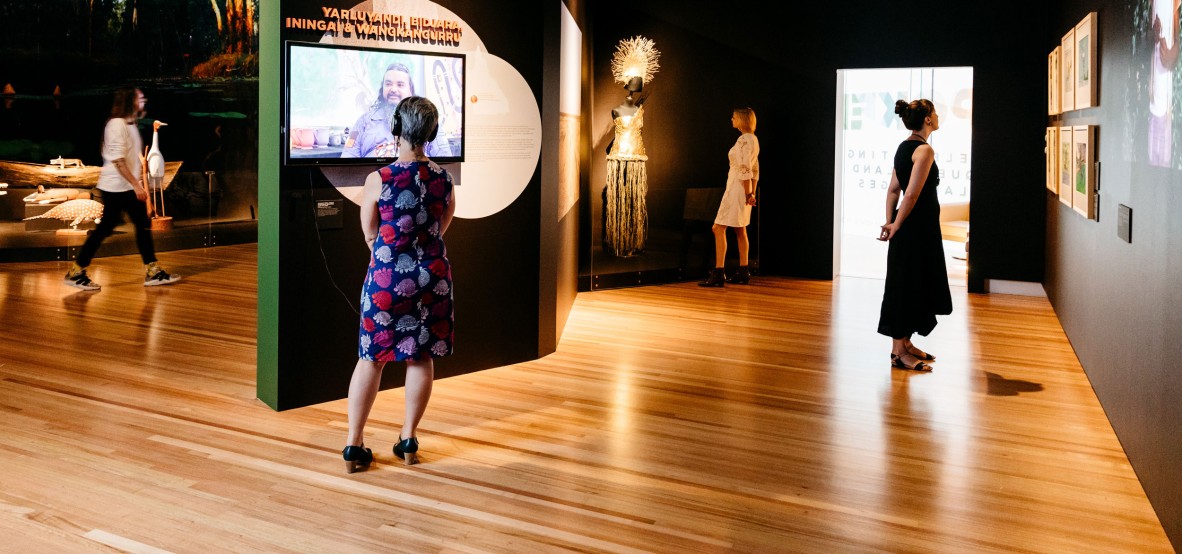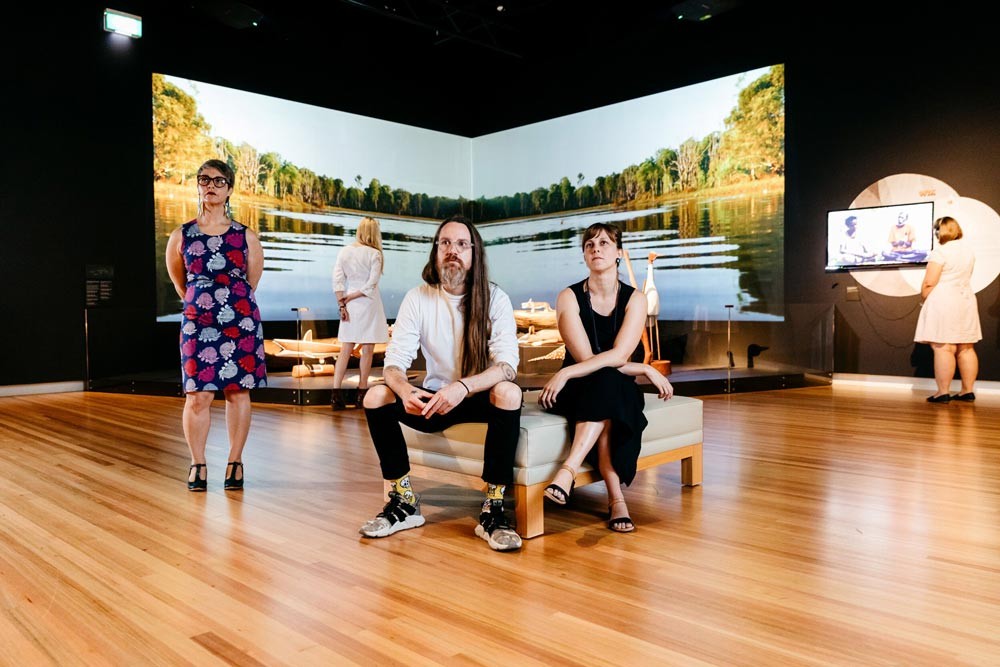In these COVID-19 times, State Library of Queensland has created a virtual tour of Spoken: Celebrating Queensland Languages exhibition to provide visitors with an opportunity to explore the diverse,yet fragile nature of Aboriginal and Torres Strait Islander languages.
The tour begins with the sounds and images of Nunukul Yuggera dance group performing a Welcome to Country on the banks of Maiwar with the stunning backdrop of Kangaroo Point cliffs and the cityscape.
As you enter the exhibition, background information is provided on Queensland Aboriginal and Torres Strait Islander languages - there are ~125 languages and dialects, of these only 2 are considered thriving or living languages! In order to be classified as a thriving language, linguists believe there needs to be a minimum of 750 speakers across all generations; essentially it is a community language spoken on a daily basis. The remainder are considered endangered with many undergoing language revival processes through the passionate actions of community members.

Spoken exhibition.
Since 2006, the State Library's Indigenous Languages Project has supported 105 languages through workshops and other research activities. We are privileged to showcase the work of these communities through Spoken as community members generously share their language journeys. 55 languages are represented within the Spoken exhibition.
The next gallery space focuses on first encounters - a highlight being the Cook Journal; however, alongside this written document stands the oral history of the Guugu Yimithirr people told by Harold Ludwick. It provides the 'shore to ship' perspective and fills in the 'gaps' not seen or understood by Cook, Banks and others on the Endeavour. Harold also provides a deeper understanding of the first Aboriginal word recorded in Queensland.
Artworks by Vernon Ah Kee, Jennifer Herd and others depict the impact of first contact and form part of the truth-telling component of the exhibition that unpacks frontier wars, protection and missions. Historical documents such as the Select Committee into the Native Police (1861) complement the art and artefacts of this space. Often at State Library workshops, the topic of silver lining to a dark era comes up in conversation - this section highlights that hidden gems of language are often found in the pages of these sad times.
Despite this upheaval, language survived away from the ears of Government officials, kept strong within family and community. This resilience and strength is celebrated in the main gallery which showcases the amazing work of community in reclaiming and using language in schools, communities through art, song, story and dance. It showcases five regions and their work - Yugambeh, Guugu Yimithirr, Wik Mungkan, Yuwibara and the Central-West representing Bidjara, Yarluyandi, Wangkangurru and Iningai. While each language journey is distinct, all share common elements of passion, cultural strength and the desire to ensure language knowledge is passed onto the next generation.

Spoken community language gallery space.
This space is alive with the sounds and images of language; community voices fill the gallery and visitors are transported to each region to better understand the important connection of country and culture. Digital stories tell of languages lost then found, of language spoken right through, of languages now spoken freely in schools and communities - all of these are part of the language landscape of Queensland.
While our virtual tour ends here, State Library encourages visitors to discover more about Aboriginal and Torres Strait Islander languages and reflect on the shared history and culture of Queensland. The Resources Lounge may not be available but the resources from the exhibition, including the digital stories can be found on the Spoken online exhibition webpages. Information on the languages represented in the exhibition and other languages can be further investigated via the State Library's interactive languages map.
State Library hopes you enjoy the virtual tour of Spoken: Celebrating Queensland Languages.
Desmond Crump
Indigenous Languages Coordinator, State Library of Queensland
State Library of Queensland Aboriginal and Torres Strait Islander Languages Webpages
State Library of Queensland Aboriginal and Torres Strait Islander Languages Map
Spoken: Celebrating Queensland languages exhibition
Jarjum Stories exhibition
Minya Birran: What next for Indigenous Languages?
References and Further Readings
The following is a selection of collection items featured in the Spoken exhibition.
Banks, J. and Beaglehole, J. C. (1962) Endeavour journal of Joseph Banks 1768-1771. J910.910.0461 BAN
Banks, J. and Dalton, J. D. (2011) Journal of the Right Hon. Sir Joseph Banks during Captain Cook's First Voyage in H.M.S. Endeavour in 1768-71. 910.41 BAN 2011
Barlow, H. (1873) "Vocabulary of Aboriginal Dialects of Queensland", The Journal of the Anthropological Institute of Great Britain and Ireland, 1873, Vol.2, pp.165-175.
Cook, J. and Wharton, W.J. L. (1968) Captain Cook's journal during his first voyage round the world, made in H.M. Bark Endeavour, 1768-71 : a literal transcription of the original mss. / With notes and introduction edited by Captain W.J.L. Wharton. Q 910.4 COO
Devaney, J. (1929) The Vanished Tribes. J A823.2 DEV
Harriet Barlow Manuscript ca. 1865. OM91-69
Journal of the HMS Endeavour, 1768-1771. MS1, National Library of Australia.
Meston, A. (1895) Queensland Aboriginals: proposed system for their improvement and preservation : addressed to the Honourable Horace Tozer. RBJ 572.89915 MES
OM64-17 Archibald Meston Papers.
OM78-92/4 Charles Wray Finch Papers 1842-1860
OM79-32/17 W Ridley Notebook, 1855.
Petrie, C. C. (1932) Tom Petrie’s Reminiscences of Early Queensland. J 994.32 PET
Phillips, R. (1898) “Vocabulary of Australian Aborigines in the Neighbourhood of Cooktown, North Queensland”. In The Journal of the Anthropological Institute of Great Britain and Ireland, Vol. 27 (1898), pp. 144-147. Online access via One Search.
Ridley, W. (1866) Kamilaroi, Dippil, and Turrubul: languages spoken by Australian aborigines. RBJ 499.15 RID
Ridley, W. (1875) 2nd edn, Kamilaroi and other Australian Languages. Q 499.15 rid
Watson, F. J. (1944) “Vocabularies of four representative tribes of South Eastern Queensland”; supplement to the Journal of the Royal Geographical Society of Australasia (Queensland), No. 34, Vol XLVIII. REFJ 499.15 wat
Comments
Your email address will not be published.
We welcome relevant, respectful comments.